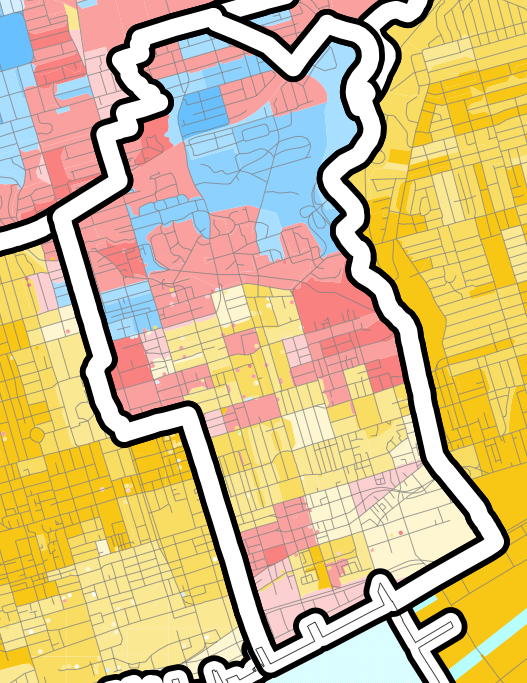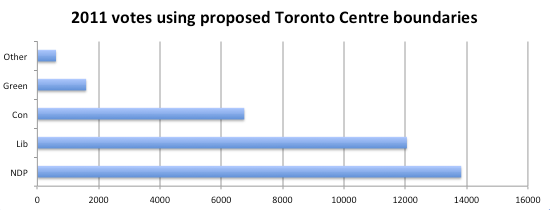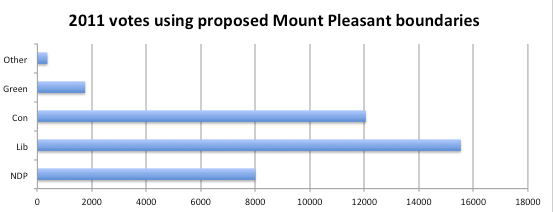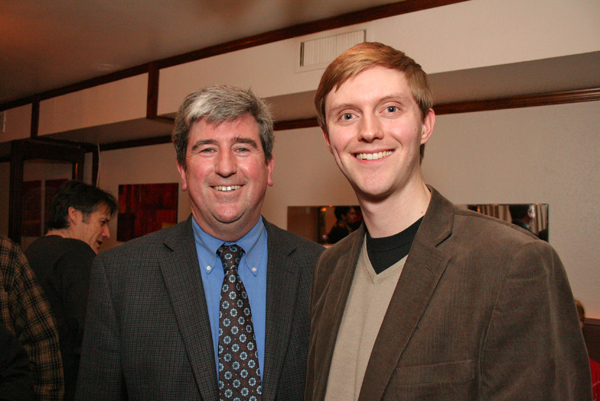Overall, Wells’s first rule — that “for any given situation, Canadian politics will tend toward the least exciting possible outcome” — held up. This is the result you might have predicted, and that most of us did predict. Folks in Toronto Centre are used to voting Liberal, and changing habits is hard.
Notwithstanding, each of the other three main parties had notable results, good and bad. At 36%, the NDP with Linda McQuaig achieved its highest percentage of the vote ever in this riding. The Greens, on the other hand, had their worst result since 1997 (2.95%) and the Conservatives, who used to hold the riding, hit an all-time low of 8.7%.
It’s impossible to say and risky to speculate specifically why the votes went that way, but I will speculate anyway, based almost entirely on my only-slightly-informed gut.
First, I think the Toronto Centre NDP has taken a positive national trend and backed it up with organizing on the ground. For the past five years, as the party has been increasingly seen as a viable, mainstream choice, the local organization has built momentum and capacity. For the last two elections the NDP haven’t just finished second in Toronto Centre, they have finished first in the south half of the riding. That wouldn’t matter, except that in 2015 the south half of the riding will be cleaved from the north to form a new “Toronto Centre” that will be the NDP’s to lose.
Expect a highly competitive NDP nomination race in the new Toronto Centre for 2015. Also expect McQuaig, if she runs again, to no longer run a campaign focused primarily on residency since, somewhat awkwardly, she lives in the wealthier, north half of the riding (to become part of “University-Rosedale”).
By all accounts Conservative Geoff Pollock was a good candidate who earned the support of prominent conservatives and the respect of his opponents. But this campaign was perfectly timed to coincide with the government’s most damaging scandal yet, and even Pollock has admitted that hurt him. The Pollock campaign has to take some of the blame for their disappointing results — perhaps their ground game wasn’t strong — but it isn’t hard to imagine the Conservative collapse here was mostly a message being sent to the national party. Either way, this does not look like a party poised to take University-Rosedale anytime soon.
@christindal I wonder how much of it was his suggestion that those who can’t afford to live downtown shouldn’t. That lost him my vote.
— Emily M. (@EmilyKnits) November 26, 2013
The poor Green result, on the other hand, is likely more attributable to the local campaign than the national party. In by-elections just one year ago Chris Turner earned 25.65% in Calgary Centre and Donald Galloway got 34.30% in Victoria, and I don’t see any reason to believe they couldn’t do so again today. This time around in Toronto Centre, John Deverell was a disappointing candidate. During the campaign’s first televised debate he was widely mocked by pundits for answering every question on every topic with a non-sequitur about proportional representation (an issue important to me too, but not to this obsessive extreme). At the next televised debate, he claimed we don’t live in a democracy (like, at all) and referred to Stephen Harper multiple times as a literal “dictator.” In yet another debate at Jarvis Collegiate he lost votes when he said, Rob Ford-like, that people who can’t afford to live downtown should just move somewhere else, and that Toronto has too many people anyway.
Deverell basically suggests if Toronto housing price is too high, you should move to where it’s cheaper. Crowd not impressed #TorCenDb8
— Siobhan Morris (@siomo) November 21, 2013
Recent general and by-election results suggest that Green votes may therefore be disproportionately influenced by local candidates, compared to other parties where the rule of thumb is that the local candidate can only influence the party’s vote by 5% or so in either direction. That’s a challenge for Greens, since it’s hard to convince strong candidates to run in elections they’re likely to lose.
Finally, I’m a bit sad that this was the last Toronto Centre election with these boundaries. Many people believe that it doesn’t make sense for a region with such extreme disparity of wealth and housing type to be represented by one MP, and voters in all parts of the riding sometimes resented those in other parts for their perceived influence on election outcomes. But I really wanted it to work. I wanted Toronto Centre to be a microcosm for all of urban Canada, where we could prove that we have more in common than we realized, and where politicians fought to unite us rather than divide us. Now it will likely settle into being two comfortable seats for the NDP and the Liberals, with no electoral incentive for politicians to appeal to the city — or even just the downtown — as a whole.
After 2015, New Democrats in the new Toronto Centre will be relieved to finally have a voice in Ottawa, and Liberals in University-Rosedale won’t have to worry about encroaching socialism from the south (though maybe from the west, since they’ll be combined with some of the current Trinity-Spadina riding). Anyway, I don’t begrudge anyone having the representation they want, but I hope that when they celebrate what they’ve gained, they don’t also celebrate what they’ve lost.



